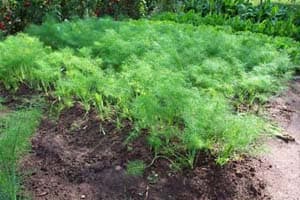How to Grow Fennel Herb Plants

About Growing Fennel Plants in Your Herb Garden
While classified as a herb, Fennel plants are a popular European vegetable. Native to the Mediterranean region, the bulbous base and stalk of this plant is popularly eaten raw like celery, cooked, or boiled. Closely related to Parsley, Fennel is popular in Italian and other Mediterranean recipes. Also called Florence Fennel or Finuccio, it is easy to grow and very hardy, surviving in your garden, well after the first frost. With bright green, fern-like leaves and aromatic yellow flowers, this plant will grow three to four feet tall. Plant it in the back of the herb garden, or in your vegetable garden.
The plant foliage and seeds have an anise-like flavor.
Plant height: Grow up to 5 feet tall depending upon variety. However, most varieties used in home gardens grow 1 to 3 feet tall.
Hardiness Zones: 4 – 9
Perennial, Nigella Hispanica
Culinary Uses
Having an Anise-like taste, the bulbs and stalks are eaten raw like celery. And they are used in a variety of Italian and other ethnic foods.
The leaves are used in sauces, soups, and condiments.
The oil is used to flavor liqueurs, candy, fish, and medicine. Oil of Fennel is used in soaps, too.
Fennel Plant Propagation
Grow Fennel plants from seed. Directly sow Fennel seeds into your garden as early in the season as the ground can be worked. Sow seeds and cover with 1/4″ of soil.
Start a new planting in mid-summer, to harvest in the fall.
Final Plant Spacing: Space seedlings or thin plants 10-12″ apart, in rows 18-24 inches apart.
Days to Germination: 14 – 20 days.
How to Grow Fennel Herb Plants
Fennel is easy to grow. The plants grow best in cool weather. These hardy plants make a great Fall crop.
The plants prefer full sun and well-drained soil. They will do best in rich soils. Water them during dry periods, once or twice per week. Add a general-purpose fertilizer once or twice a season.
Harvest Fennel leaves at any time. Harvest flower heads after seeds have formed, and the flower head has died. Extract seeds and dry them in a cool, dry location.
Harvest bulbs when they reach tennis ball size or bigger. Pull every other one out as needed, to allow those remaining to grow even bigger.
Do not pull these plants up in advance of the first frost. They are very hardy and should continue to thrive and grow, even after several hard frosts.
Ideal pH: 5.0 – 6.0
Insect and Plant Disease Problems
Related Articles
Please support our site. Shop for:
- rmmatthews100@hotmail.com
- 585-721-6528
- Rochester, NY
©1999-2024 GardenersNet.Com, All Rights Reserved

